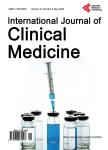Predictors for Massive Haemorrhage during Caesarean Delivery Due to Placenta Praevia
Predictors for Massive Haemorrhage during Caesarean Delivery Due to Placenta Praevia作者机构:Department of Obstetrics and Gynaecology Academic Medical Centre University of Amsterdam Amsterdam The Netherlands Department of Obstetrics and Gynaecology Leiden University Medical Center Leiden The Netherlands Department of Obstetrics and Gynaecology Spaarne Ziekenhuis Hoofddorp The Netherlands Department of Obstetrics and Gynaecology Onze Lieve Vrouwe Gasthuis Amsterdam The Netherlands Department of Obstetrics and Gynaecology School of Paediatrics and Reproductive Health University of Adelaide Adelaide Australia
出 版 物:《International Journal of Clinical Medicine》 (临床医学国际期刊(英文))
年 卷 期:2015年第6卷第2期
页 面:96-104页
学科分类:1002[医学-临床医学] 100214[医学-肿瘤学] 10[医学]
主 题:Placenta Praevia Massive Haemorrhage Caesarean Section Predictors
摘 要:Objectives: To describe the incidence and predictive factors for massive haemorrhage during a caesarean delivery in women with placenta praevia. Methods: We performed a retrospective cohort study among consecutive women with a placenta praevia planned for a caesarean delivery between 2001-2011 in one academic centre and two teaching hospitals in the Netherlands. Massive haemorrhage was defined as ≥1000 mL blood loss during caesarean section. We used logistic regression analysis to assess which maternal and pregnancy characteristics were predictors for massive haemorrhage during caesarean delivery. Results: Of 54,794 deliveries, we identified 215 (0.39%) women with placenta praevia who underwent a Caesarean delivery, of whom 94 (44%) had massive haemorrhage at or after surgery. After univariable preselection, multivariable logistic regression indicated that higher maternal age (OR 2.09;95% CI 1.17 - 3.74), no Caucasian ethnicity (OR 1.73;95% CI 0.92 - 3.27), multiple pregnancy (OR 3.92;95% CI 0.72 - 21.28), lower systolic blood pressure during pregnancy (OR 1.03;95% CI 1.00 - 1.07) and the placenta located at the anterior wall (OR 2.21;95% CI 1.20 - 4.04) were independent predictors for massive haemorrhage during a caesarean delivery in women with placenta praevia. Predicted probabilities varied between 22% and 71%. The model has a reasonable discriminative ability and acceptable calibration. Conclusions: Women with placenta praevia are at high risk for massive haemorrhage during caesarean delivery. The risk profile can be used to identify extreme high-risk women in whom extensive preventive measures are justified.



